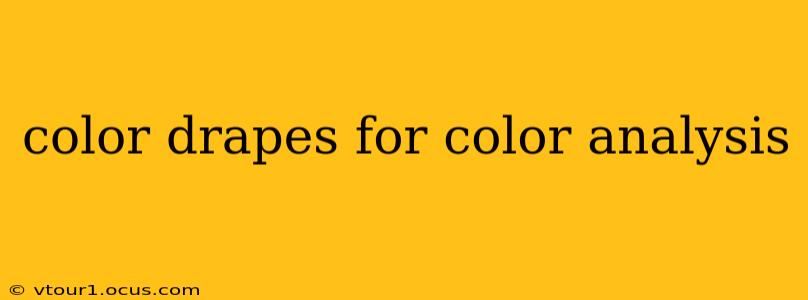Color analysis, also known as seasonal color analysis, is a system used to determine which colors best complement your natural coloring—hair, skin, and eyes. This system helps you choose clothing, makeup, and even hair color that enhances your features and makes you look your best. A crucial part of this process involves using color drapes. This comprehensive guide explores the importance of color drapes in color analysis, how they're used, and what to consider when choosing them.
What are Color Drapes Used For in Color Analysis?
Color drapes are fabric swatches in a variety of colors, meticulously chosen to represent the different color seasons (Spring, Summer, Autumn, and Winter). They're held up against a person's face to assess how different hues affect their complexion. The goal is to identify which colors bring out their best features, making their skin appear brighter, their eyes sparkle, and their overall appearance more vibrant. Conversely, it helps determine which colors drain their complexion, making them look washed out or sickly. This isn't about subjective preference; it's about objective observation of how color interacts with your natural coloring.
How are Color Drapes Used During a Color Analysis Session?
A color analysis session typically involves a trained consultant who uses a set of color drapes to compare various shades against your face. The consultant will systematically hold each drape near your face, observing the effects on your skin tone, eye color, and hair. They'll look for subtle differences, noting how each color interacts with your natural pigments. This process helps pinpoint your specific color season and the most flattering colors within that season. The drapes provide a controlled environment for making accurate observations, eliminating the variables that come with naturally-colored clothing or fabrics.
What are the Different Types of Color Drapes Available?
While the core principle remains the same, the specific color palettes and the quality of materials can differ across drape sets. Some sets offer a basic range of colors representing the four seasons, while others offer more nuanced shades and variations within each season. You can find drapes made from different fabrics like silk, satin, or even cotton. The choice of fabric can subtly affect the way the color is perceived, but the main focus remains on the color itself.
What is the Best Fabric for Color Drapes?
The ideal fabric for color drapes is a matter of some debate among color analysts. However, many prefer matte fabrics that don't reflect too much light, allowing for a more accurate assessment of the color's impact on the skin. Shiny fabrics can distort the color and create unwanted reflections that interfere with the analysis. A relatively opaque fabric is also preferred so that the color of the drape doesn't bleed or show through.
Where Can I Find Color Drapes?
Color drapes can be purchased from various online retailers and specialist color analysis suppliers. However, purchasing a pre-made set often means you don't have as much control over the specific shades included. Some consultants create their own drapes ensuring accuracy and matching to their teaching style. If you are considering learning Color Analysis, selecting a well-made set of drapes is an important investment for your professional practice.
Are DIY Color Drapes as Effective as Professional Ones?
While creating your own color drapes might seem cost-effective, it's challenging to replicate the accuracy and consistency of professionally created drapes. Professionally made drapes are carefully calibrated to provide a standardized assessment across different lighting conditions. DIY drapes may lack the precision needed for accurate color analysis, potentially leading to inaccurate results.
Conclusion:
Color drapes are an invaluable tool for color analysis. They provide a controlled and effective way to determine your best colors, enabling you to make informed choices about your wardrobe and makeup, resulting in a more polished and confident appearance. Investing in a good quality set, or working with a trained professional, is crucial for achieving accurate and beneficial results.
